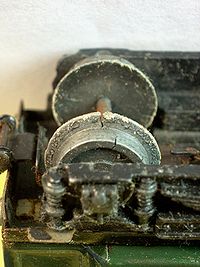
Zinc pest
Encyclopedia

Zinc pest, is a destructive, intercrystalline corrosion
Corrosion
Corrosion is the disintegration of an engineered material into its constituent atoms due to chemical reactions with its surroundings. In the most common use of the word, this means electrochemical oxidation of metals in reaction with an oxidant such as oxygen...
process of zinc
Zinc
Zinc , or spelter , is a metallic chemical element; it has the symbol Zn and atomic number 30. It is the first element in group 12 of the periodic table. Zinc is, in some respects, chemically similar to magnesium, because its ion is of similar size and its only common oxidation state is +2...
alloy
Alloy
An alloy is a mixture or metallic solid solution composed of two or more elements. Complete solid solution alloys give single solid phase microstructure, while partial solutions give two or more phases that may or may not be homogeneous in distribution, depending on thermal history...
s containing lead impurities. It was first discovered to be a problem in 1923.
Zinc pest affects primarily die-cast
Die casting
Die casting is a metal casting process that is characterized by forcing molten metal under high pressure into a mold cavity. The mold cavity is created using two hardened tool steel dies which have been machined into shape and work similarly to an injection mold during the process...
zinc articles that were manufactured during the 1930s, 1940s, and early 1950s. In Germany, articles made from Zamak
ZAMAK
Zamak is a family of alloys with a base metal of zinc and alloying elements of aluminium, magnesium and copper. Zamak alloys are part of the zinc aluminium alloy family; they are distinguished from the other ZA alloys because of their constant 4% aluminium composition...
during World War II
World War II
World War II, or the Second World War , was a global conflict lasting from 1939 to 1945, involving most of the world's nations—including all of the great powers—eventually forming two opposing military alliances: the Allies and the Axis...
and several years thereafter may be affected. Purer alloys were not available to the manufacturers as they were used for the war effort, or were just not on the market after the war. While impurities of the alloy seem to be the cause of the problem, environmental conditions such as high humidity
Humidity
Humidity is a term for the amount of water vapor in the air, and can refer to any one of several measurements of humidity. Formally, humid air is not "moist air" but a mixture of water vapor and other constituents of air, and humidity is defined in terms of the water content of this mixture,...
(greater than 65 %) may accelerate the process. Also, significant temperature changes can be damaging.
Affected objects may show surface irregularities such as blisters or pitting. They expand, buckle, tear, and in the end, crumble. The irreversible process will eventually destroy the object. Due to the expansion process, attached normal material may be damaged secondarily. Zinc pest is different from a superficial white oxidation process ("Weissrost") that may affect some zinc articles.
Zinc pest is dreaded by collectors
Collecting
The hobby of collecting includes seeking, locating, acquiring, organizing, cataloging, displaying, storing, and maintaining whatever items are of interest to the individual collector. Some collectors are generalists, accumulating merchandise, or stamps from all countries of the world...
of old model trains, toys, or radios where the zinc die-cast process
Die-cast toy
The term die-cast toy here refers to any toy or collectible model produced by using the die casting method. The toys are made of metal, with plastic, rubber or glass details. Wholly plastic toys are made by a similar process of injection moulding, but the two are rarely confused...
was used. Valuable items are rendered worthless but for their residual parts. Also parts of engines of older vehicles or airplanes and military medals may be affected.
Articles made after 1960 are generally considered free of the risk of zinc pest. Use of purer materials and more controlled manufacturing conditions make it unlikely that modern zinc articles will encounter degradation by zinc pest. However, some model aircraft produced between 2001-2003 by certain brands have fallen victim to zinc pest.
Zinc pest is not related to tin pest
Tin pest
Tin pest is an autocatalytic, allotropic transformation of the element tin, which causes deterioration of tin objects at low temperatures. Tin pest has also been called tin disease, tin blight or tin leprosy ....
.

